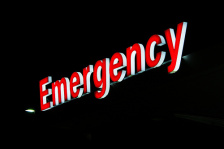 Carbon monoxide (CO), by definition, is a colorless, odorless toxic flammable gas formed by incomplete combustion of carbon. Carbon monoxide is created by the incomplete burning of fuels including coal, wood, charcoal, oil, kerosene, propane, and natural gas. Open flame isn’t the only way carbon monoxide is produced; it is also produced by combustion engines including those in portable generators, vehicles, lawn mowers, and gas-powered power tools. Today I want to address safety measures, symptoms of CO poisoning, emergency procedures, and prevention of CO poisoning.
Carbon monoxide (CO), by definition, is a colorless, odorless toxic flammable gas formed by incomplete combustion of carbon. Carbon monoxide is created by the incomplete burning of fuels including coal, wood, charcoal, oil, kerosene, propane, and natural gas. Open flame isn’t the only way carbon monoxide is produced; it is also produced by combustion engines including those in portable generators, vehicles, lawn mowers, and gas-powered power tools. Today I want to address safety measures, symptoms of CO poisoning, emergency procedures, and prevention of CO poisoning.
Carbon Monoxide Poisoning
About 170 people die from CO produced by non-automotive products each year in the United States alone. Non-automotive carbon monoxide producers include malfunctioning furnaces, ranges, water heaters, and heater units. They also include portable generators, fireplaces, wood burning stoves, and charcoal.
Carbon Monoxide Emergency Procedures
CO is completely undetectable by humans. This simple fact alone makes it very deadly. Symptoms of carbon monoxide poisoning are similar to flu symptoms without the accompanying fever. Many people who are otherwise healthy complain of headache, fatigue, shortness of breath, nausea, or dizziness. Some or all of the symptoms may appear.
Severe CO poisoning produces more severe symptoms, including mental confusion, vomiting, loss of muscle coordination, loss of consciousness, or untimely death. Again, some or all symptoms may appear, and are often mistaken for the flu.
Any time you suspect CO poisoning, go outside for fresh air immediately. Call your local fire department from a phone outside your home; use a neighbor’s phone or a cell phone outside your home. Rush the victim to the emergency room at once if they lose consciousness. If you are the victim, please do not drive, ask someone to take you or call 911 for emergency assistance. Don’t take a chance on driving yourself in case you lose consciousness.
Call a qualified professional for assistance with faulty appliances if the doctor confirms CO poisoning.
Prevent Carbon Monoxide Poisoning
Carbon monoxide poising can be prevented by taking the following safety precautions.
1. Install carbon monoxide detectors in your home and garage. Change their batteries once a year to ensure proper functionality.
2. Make sure all gas appliances are installed properly and working properly.
3. Never burn charcoal indoors.
4. Never operate unvented fuel-burning appliances indoors.
5. Never use your gas-powered appliances as your heat source.
6. Never use aluminum foil on the bottom of a gas-powered stove.
7. Schedule chimney and fireplace inspections each year.
8. Educate your family on the dangers of CO poisoning.
Fireplaces Can Produce Carbon Monoxide
Because CO is a byproduct of combustion, it can be produced by your fireplace. Make sure you burn the right types of wood, don’t burn things you shouldn’t burn, and have a certified chimney sweep inspect and clean your fireplace and chimney once a year. Schedule a visit from the chimney sweep on the same day you change the batteries in your smoke alarm and carbon monoxide detector so you take care of everything in a single day.
